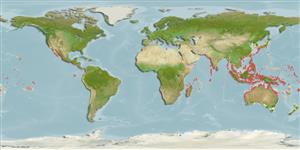Malacostraca |
Decapoda |
Palaemonidae
Environment: milieu / climate zone / গভীরতার পরিসীমা / distribution range
বাস্তুসংস্থান
রীফ সংশ্লিষ্ট; গভীরতার পরিসীমা 1 - 15 m (সূত্র 113378). Tropical
Indo-Pacific: Mozambique to Japan, Australia and Papua New Guinea.
Length at first maturity / আকৃতি / Weight / Age
পরিপক্কতা : Lm ? range ? - ? cm
Body is transparent with large white spots. Four to five orange spots with a black ring are present on the tail fan. Purplish-blue rings are present near the joints and tips of pereiopods. Rostrum well-developed, with five to six dorsal, and two ventral teeth. Females are generally larger.
Minimum depth from Ref. 83472. Epizoic, Intertidal to subtidal (Ref. 106854). Associated with giant anemones (Ref. 113378). Usually found in pairs. Occasionally found on hard corals (Ref. 125532).
Life cycle and mating behavior
পরিপক্কতা | প্রজনন | ডিম ছাড়া | Eggs | ডিম্বধারন ক্ষমতা | Larvae
Members of the order Decapoda are mostly gonochoric. Mating behavior: Precopulatory courtship ritual is common (through olfactory and tactile cues); usually indirect sperm transfer.
Bruce, A.J. 2005 Pontoniine shrimps from Papua New Guinea, with designation of two new genera, Cainonia and Colemonia (Crustacea: Decapoda: Palaemonidae). Memoirs of the Queensland Museum 51(2):333-383. (সূত্র 83471)
IUCN Red List Status
(সূত্র 130435: Version 2025-1)
CITES status (সূত্র 108899)
Not Evaluated
Not Evaluated
Threat to humans
Human uses
| FishSource |
হাতিয়ার
আরো তথ্য
ট্রফিক বাস্তুতন্ত্র Food items (preys)
পথ্য উপাদান
খাদ্য গ্রহণ
শিকারী প্রাণী সমূহ
Population dynamicsবৃদ্ধি
Max. ages / sizes
Length-weight rel.
Length-length rel.
Length-frequencies
Mass conversion
প্রাচুর্য
Life cycleপ্রজনন পরিপক্কতা ডিম্বধারন ক্ষমতা ডিম ছাড়া EggsEgg developmentLarvae Physiologyঅম্লজান ব্যবহার
Human RelatedStamps, coins, misc.
ইন্টারনেট সুত্র
Estimates based on models
Preferred temperature
(Ref.
115969): 22.9 - 29.3, mean 28.3 (based on 3320 cells).
